This post is also available in: Kreyol
There are countless references of Haiti in international media, and comics books are no exception.
I still remember the shock and excitement I felt when I first read a Creole word in a comic book. I’ve been reading comics most of my life. Although I specialized in Batman, the books I read go far beyond Marvel and DC. Comic books have always been an escape from where I lived and sometimes from who I was. They represented a looking glass through which I would lose sight of my reality. Between these magical and colorful pages, I could forget the shortcomings of my country, the inadequacies of my teachers, and my own insecurities. In exchange, my mind could wander in places such as planet Oa, and I could be inspired by characters overcoming their own setbacks.
Of course, when you venture so far from home, the last thing you expect to find is… home. In the pages of Batman: No Man’s Land Volume 1 which came out in 1999, I came across my first reference of Haiti in the form of a sentence that stuck with me ever since: “Papa Legba, ouvri baryè a pou mwen pou mwen pase!” (Papa Legba, open the gates, that I may enter!) No pun intended, but in many ways that reference opened the gates to many things in my life, including the Haiti reference list I have compiled here. As I gathered them, I noticed a trend: they were all about Vodou. Some are well researched while most are merely clichés. I avoided including the latter here unless they are of historical significance. I also avoided actual Haitian characters, as they are mostly caricatures such as Brother Voodoo, Sister Voodoo, Doctor Voodoo etc. The following are references that I find of cultural weight or thought provoking from a storytelling point of view.
Reference # 1: Sub-Mariner Comics (1941) #13 – Dead who Swim (1944)
This is probably the oldest reference of Haiti in comics. It was published in March 1944, just four years after Marvel started making comic books. Unfortunately, the reference is as stereotypical as it is old. At one point in this issue, at the mere mention of the island of Haiti, Namor the Sub-Mariner exclaims: “Haiti! Haiti is famed among all the West Indian people for its zombies.” In her paper Haitian Vodou: Cultural Appropriation in American Videography, the academic author Shauna Healey states: “From saving the souls of possessed children, to a zombie take over leading to the apocalypse, Americans have been conditioned to shudder at the language and culture associated with Vodou.” It is hard to say whether this reference, possibly the oldest one, was influenced by this trend or if it participated in establishing it.
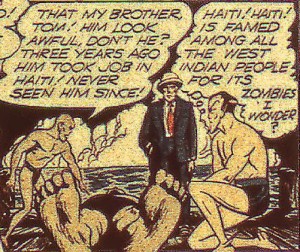
Reference # 2: Batman: Arkham Asylum (1989)
The Arkham Asylum has always been a centerpiece in the Batman mythology. While Batman relies on psychology to defeat villains, the city of Gotham relies on psychiatry to rehabilitate them. Joker, a prominent Batman enemy has always proven to be a most difficult patient to grasp. The reason why he became the Joker is one of the greatest secrets in the history of comic literature. In Batman: The Killing Joke, another story that delves into the psychology of the Joker, the Clown Prince of Crime himself confesses: “Sometimes I remember it one way, sometimes another… If I’m going to have a past, I prefer it to be multiple choice! Ha Ha Ha.” To explain his insanity, Joker apparently tells his psychotherapist that he is possessed by the Haitian Vodou Lwa, Bawon Samdi. In Vodou, because possession is not easy to attain, initiates have to work hard to achieve a sense of mental clarity and spirituality in order to be receptive to a Lwa. So the Joker is basically claiming that he is a Vodou practitioner. While Baron and Joker certainly have the white face, the nasal tone, the purple color and the cult of death in common, I’m as skeptical of this claim as any other the Joker makes about “how he got his scars.” However, as far as multiple choice questions go, the answer may simply be: “all of the above” when it comes to Joker.
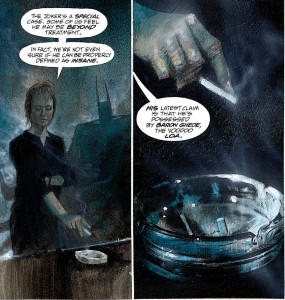
Reference # 3: The Invisibles Volume 1 #10: Season of the Ghouls (1995)
In the annotations for this book the author mentions Divine Horsemen: The Living Gods of Haiti, a 1953 book and a later released documentary shot in Haiti by the ethnographer Maya Deren and The Vodun Gnostic Workbook by Michael Bertiaux, among many other scientific and occult works as sources. Far from being a Frankenstein-like collage of clichés, although there are zombies involved, this is a fantastic story that seamlessly integrates elements from Haitian reality and imagination. In just page three, we are treated to an actual Vodou invocation of Bawon Samdi. The scene is complete with a rogatwa (altar), accurate vèvè, accurately transcribed Creole and French litanies, and a ritual sacrifice of a rooster. Other references throughout the story such as the insect Lwas, spirit food and the sacred city of La Vilokan in the north of Haiti make this entry one of the most informative and respectful of Haiti’s main religion.
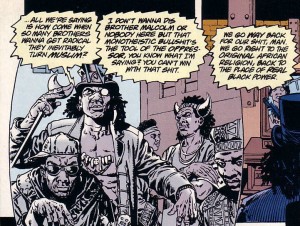
Reference # 4: Daredevil Volume 1 # 310 Devil Ge Rouge (1992)
In this book, the blind lawyer Matt Murdock is approached by an anxious Yves Chapoteau, a Haitian refugee seeking political asylum. He stammers his predicament: “I escaped Haiti soon after zee military overthrew our beloved President Aristide. I came to New York and organized a Kako Group to invade zee homeland. But zee new dictator learned of our plan and sent his men after me.” A couple pages later, unfortunately for him, Chapoteau runs right into these men. Chapoteau refers to them as Cagoulars but this is an historical inconsistency. The Cagoulars were the Clément Barbot-led militia that would later turn into the Tonton Macoutes of the Duvalier regime. Therefore, they would have been long gone before President Aristide’s first coup. Instead, judging by the timeframe and their green military uniforms they are depicted sporting in the comic, it is safe to say they were FADH and FRAPH members (Haiti’s army and paramilitary group respectively). They gang up on Chapoteau and sentence him to death on the spot by one of the most horrid ways: Pè Lebren. Nicknamed after the biggest tire dealer in Haiti, this heinous practice consists of burning someone alive with a tire around his neck. Armed groups in Haiti have a history of being used against its own people. When that happens they perpetrate many barbaric acts that traumatize whole generations. They also help paint an ugly and indelible picture of the country in international media. Though many at home want the Haitian people to forget this, I’m relieved that something, even if it is just a book, won’t let us.
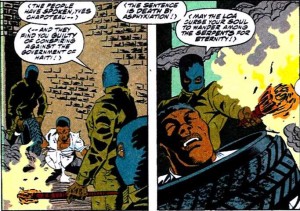
Reference # 5: Lucifer Volume 2 # 3 and 4 (2016)
An often disregarded aftermath of the tragic January 12, 2010 earthquake is the spotlight it shed on Haiti’s adoption system. A lot of predators, shrouded in the “providing relief” guise, were on the prowl for newly orphaned children and those who were separated from their parents. There was even a case of orphanage personnel turning to child trafficking. Add the fact that the apprehended perpetrators were all American, and you might understand why many Haitians are distrustful of international adoption. In this entry, we meet Medjine Parker, a Haitian orphan who was adopted by a family in Oklahoma. She has been in the U.S for eight months, and well… things are not really looking good for her. Her new family treats her very differently from their other children. She often gets remarks about her skin color and mother language. After a bad incident occurs, Medjine is quickly accused by her adoptive father. He claims that a “demon” traveled with her from Haiti and was responsible. When he goes as far as mentioning an exorcism, Medjine decides to run away.
In more ways than one, I feel like Medjine is a metaphor for Haiti itself. From 1492 until today, just like Medjine’s adoptive parents, our would-be helpers have always failed to accept us for who we are. Maybe it’s the color of our skin, maybe it’s our history; maybe it’s the mysteries of our land, maybe it’s our language and maybe it’s their fear of the relationship we have with our many gods. Something about us always seems to clash with their good intentions. They always end up either trying to force something of theirs upon us or to remove something of ours from us. This is exactly the kind of relationship you run away from.
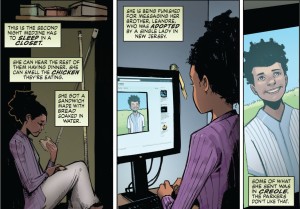
There are countless references of Haiti in international media, and comics books are no exception. Haitian culture is often exploited to make millions of dollars, but is quickly diminished as worthless, dirty and downright barbaric; especially Vodou. Unfortunately the lack of content created by people who actually live the culture and practice the religion has left even Haitians thinking the same. We, in turn, become enforcers of the stereotypes and biases against ourselves and our people. A handful of authors manage to provide respectful representations of Haiti’s culture by either flying high above the clichés and exploring real issues, or by using them as a mirror for everyone to reflect on. Researching these references I felt bad that authors so far removed from Haiti’s reality were schooling me on Vodou’s basic concepts and important issues in Haiti’s history. For so long comic books have allowed me to escape from where I lived. Maybe it’s time for me to remember who I am and head back home.

Great article…